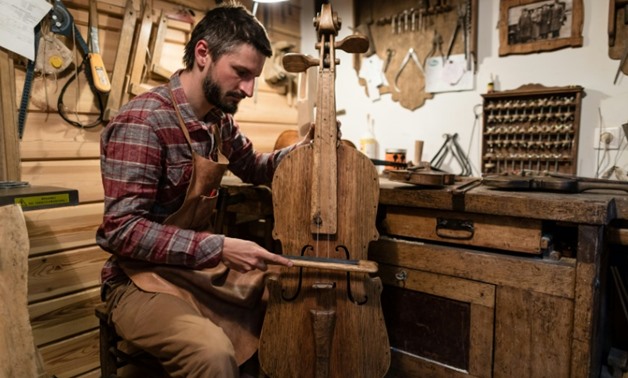
Musician and instrument-maker Mateusz Raszewski has revived the art of designing, building, stringing and playing the Kalisz bass.
Dancing couples spin, whirl and pirouette on their heels transported by the lively tempo of traditional Polish folk dances brought to life on rustic instruments, some plucked straight out of the Middle Ages.
The spirited rhythms of dances like mazurkas, obereks or owijoks played at a popular annual folk music festival in the Polish capital, Warsaw, emerge from the belly of the Kalisz bass.
The distant cousin of Renaissance and Baroque-era bass viols, it was made by peasants living near the eponymous small central town until the early 20th century and then all but forgotten.
Musician and instrument-maker Mateusz Raszewski is reviving the art of designing, building, stringing and playing this unique bass, traditionally carved by hand out of a single block of softwood like poplar or willow.
Its design was "only officially documented in the 1950s and it exists only in a small region near the river Prosna," the bearded 38-year-old, dressed in a thick flannel shirt and leather apron, told AFP, in his workshop in the village of Kaminsko, just north of the western Polish city of Poznan.
It is reminiscent of a cello, but with a shorter, thick neck and just two, or sometimes three, strings.
One foot of its bridge pierces its front panel to act as a sound post sending vibrations to the back panel of the sound box.
"This is a very old design that one finds in the Welsh crwth," Raszewski says, referring to an archaic type of bowed lyre, a string instrument, popular in medieval Europe.
"God only knows how these Kalisz peasants managed to find this design," he added.
- 'Like in the forest' -
Each instrument was unique, depending on the technical know-how, materials and tools available to the peasants.
"Some used a candle to cast a shadow of a bass on the wall so they could copy its design," Raszewski told AFP, recounting an old trick of the folk instrument trade.
Raszewski uses axes, saws and chisels similar to those that would have been used centuries ago.
He also uses metal nails to build the basses, saying that this would be "unthinkable to modern luthiers" who use pegs and glue.
"Its sound is raw, hoarse, dull. It provides the bass line and rhythm on which the violinist plays his melody," says Raszewski, of the Kalisz bass.
"It's just like in the forest: we hear the hornets' drone and the song of a blackbird perched high on a tree," he adds.
Raszewski learnt by coincidence a decade ago that his grandfather had been a luthier in Poznan, but the Nazis forced him out of business during World War II after they found out he worked with Jews.
The discovery encouraged Raszewski, who already made guitars, typical folk fiddles and various types of folk drums, to add another string to his bow.
He decided to develop his skills by researching old folk instruments in museums, archives, attics and by meeting elderly musicians.
"I met an old musician playing the Kalisz bass after first finding him on a photo from the 1950s -- nobody was interested in what he had been doing for over 50 years," Raszewski told AFP.
- 'Last chance' -
According to Katarzyna Zedel, an expert at the Szydlowiec Museum of Traditional Instruments in central Poland, the Kalisz bass was forgotten when accordions arrived on the scene in the late 19th century.
"This old world no longer exists," she told AFP.
War and politics have also taken their toll, destroying cultural artifacts, communities, customs and local know-how.
The advent of electricity, the radio, rock and roll also undermined folk culture, while Poland's Communist party distorted it for propaganda purposes before the regime fell in 1989.
"Peasants were dressed up in costumes that they had never worn at home and were told what to sing and how to dance.
"Some of the costumes were beautiful but nobody identified with them," says Piotr Piszczatowski, a musician and leading commentator on Polish popular culture.
Authentic folk culture was regarded as "representing a backward society that was no longer wanted: poor, without electricity, without toilets, shameful!" he says.
A revival began around 30 years ago when followers of celebrated Polish theatre director Jerzy Grotowski -- who developed an eclectic theatrical style that included a wide range of vocal expression including folk songs -- discovered elderly musicians near Warsaw who were still playing authentic folk music.
According to Piszczatowski, "it was a last chance" to preserve an art form with deep cultural, historic and artistic value.
"Some experts believe that mazurkas were dances created by peasant serfs -- wild, simple, primitive and energetic tunes," he told AFP.
The revival has gained steam in recent years, with rural folk dance halls springing up and the annual "All Mazurkas of the World" folk music festival in Warsaw drawing ever greater numbers of both young and old.


Comments
Leave a Comment